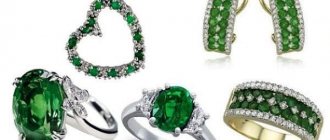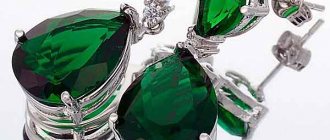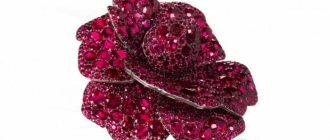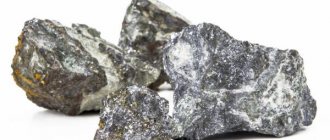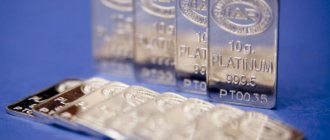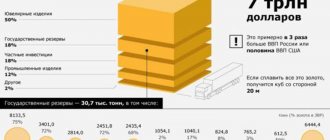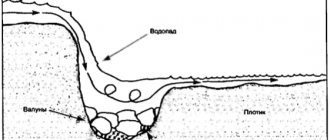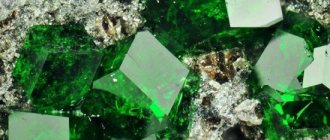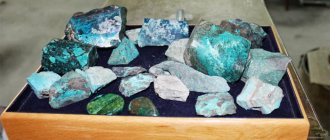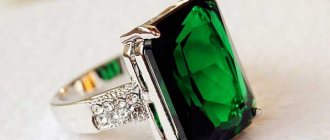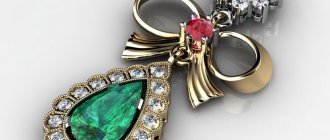Who owns the most expensive emerald mined on the planet? Why is this grass-green crystal valuable and what unique stones are known to mankind? Many large gems have an interesting and complicated history. Some are so expensive that you can only see them at exclusive shows. And others were once sold for next to nothing, although their real price was a fortune. In this article we will tell you about all the most famous and expensive emeralds.
Colombian stones as a standard
Bogota. It is here, in the vicinity of the Colombian capital, that the most expensive and beautiful gems in the world are mined at public and private mines. And it is they who are meant when they say that if a person has money, then the magic of the “second after diamond” crystal will force him to make a purchase, even if he initially did not want it.
Perhaps it was this magic that led gem buyer Reagan Rainey to purchase the 11-kilogram Theodora emerald in 2012. True, it was mined not in Colombia, but in Brazil, but the trend is important, because Rainey, having bought “Theodora” at an auction, complained that there was not much actual emerald in the purchased stone. That “there is a completely different mineral inside – beryl.” However, he parted with the money. Probably by buying into the small percentage of emerald in the stone being sold. And he gave 1 million 150 thousand dollars. No big deal, right? It cannot be compared with the Bogotá crystal “Fura”, which, weighing 2 kg, was valued at 150 million dollars.
Healing properties of gemstones
Many gems have incredible energy potential, positive vibrations, and this allows you to cure many diseases:
Existing types of gems
- various inflammations;
- skin diseases;
- bronchopulmonary, gastrointestinal diseases;
- have a good effect on a person’s mental state;
- normalize the functioning of the cardiovascular system;
- have a positive effect on female organs.
Baiyin Wanderer
The fate of a druse of emeralds mined in a mine in the Brazilian state of Bahia is interesting and confusing. This is an intergrowth of crystals weighing over 380 kg with an estimated mass of stones of about 180,000 carats. It was named after the place where it was mined (“Bahia”) and sent for exhibition and sale in the United States. The gem got there in 2005, on the eve of the famous New Orleans flood, was sunk in the safe of one of the banks, and when the water subsided and the stone was removed, it went to travel around the states, changed more than one formal owner and was eventually valued at 375 million .dollars. This is the highest price in the world.
Disputes over the owner led to the stone being “arrested” and put back in the safe. Since then, he has been inaccessible to anyone - neither reporters nor applicants for him. Even the Brazilian authorities came to their senses, declaring that the Bahia emerald is part of the country’s cultural heritage.
Originality does not mean value
Trapiche emeralds stand apart in the market for stones mined at “standard” Colombian mines. No, the word “tropics”, as one might think based on the place of extraction and the name, has nothing to do with it. However, these emeralds have an interesting history.
Trapiche is the name of a press that is used in Latin America for processing agricultural products. One of its parts is a massive cast-iron flywheel with six thick spokes.
Ironically, in the places where these presses were used, emeralds with a pattern of six green rays converging in the center of a dark crystal of a completely different rock, unrelated to emerald, are found.
Such a stone is valuable as a curiosity, and serious jewelers treat it as such. On the other hand, they are rare and arouse great interest in the world of collectors who do not skimp when buying these stones - trapice emeralds.
Meaning and education
The diamond itself is quite hard. Thanks to this property, it got its name. Translated from Arabic “al-mas”, which means “the hardest”. Even in ancient times, an uncut stone was considered an exquisite decoration and had currency value.
An example of an uncut diamond
One of the reliable stories of the formation of diamonds is considered to be of magmatic origin. Carbon atoms form at great depths like diamonds and are carried to the surface by magma.
There is also a meteorite version of the formation of gems. The raw crystals themselves are unsightly in appearance. They look like matte and rough grains up to 5 mm in size.
When mining you can find:
- isolated crystals;
- fused small crystals;
Appearance of a diamond in nature
- several hundred cobbled-together units.
Remnant of Genghis Khan's Empire
In 1695, a Spanish galleon moored at one of the Indian ports. On board was an emerald of grass-green color, with a uniform structure and almost without foreign inclusions. Even then it was clear that it was very expensive, and it was not without reason that the Spaniards decided to sell it to the reigning house of the Mughal Empire in order to strengthen relations. In addition, green is the favorite color of Muslims, because the Prophet Muhammad himself preferred it.
A descendant of the Genghisids, Emperor Aurangzeb, bought an emerald (as emerald was called in ancient times) and ordered the court jeweler to carve a saying from the Koran on one flat side, and a beautiful floral pattern on the other. The stone was kept in this form for 4 centuries until it was sold at Christie’s auction to a new owner from Qatar for $2.2 million. The emerald is called the “Great Mogul”. This is one of the most famous stones in the world.
What makes a mined emerald a gem?
Only the most experienced jewelers take on emerald cutting. But they will not risk once again getting involved with a bad workpiece, because foreign inclusions in natural stone are not everything. There are always microcracks in it, which increase the risk of damage during cutting.
A flawless emerald is extremely rare, so its cost ranges from 2 to 25 thousand dollars per carat. If the carat price is less, then there are cracks in the stone, but they are filled with silicate glue or polyester resins.
What does this mean for a potential buyer:
- such an emerald cannot be washed, as the adhesive substance will be washed away;
- volatile solvents (for example, ethyl alcohol) can ruin the stone;
- cracks force jewelers to make a frame closed at the bottom, which reduces the refraction of light in the facets of the emerald;
- The world's most effective ultrasonic jewelry cleaning machines can crush stones.
However, even flawed emeralds are much more valuable than the best lab-grown counterpart.
Interesting fact: according to popular belief, emerald helps in business, new endeavors, love affairs and creativity, but is not suitable for Pisces, Capricorns and Scorpios.
Semiprecious stones
Aquamarine
A transparent stone with shades of blue and green. Its price is $30-60.
Amethyst
The most expensive quartz stone on the list. The cost of the most valuable stone is from $10.
Turquoise
The mineral was found several thousand years ago. Its cost depends on the color.
Demantoid
Belongs to grenades. The cost of 1 carat is from 100 to 500 dollars.
Grossular
Very similar to demantoid. Costs from $700.
Ural competitors to Colombians: small does not mean cheap
In Russia, industrial mining of emeralds by private companies began in the 2000s. This caused both a surge of interest in these stones and an increase in prices for jewelry with emeralds. Yes, sometimes jewelry stores write “emerald” on the price tag, adding “emerald” in parentheses.
Ural stones are not only not inferior, but often superior to Colombian ones. Their cost in showrooms reaches 5 thousand dollars per carat and more. By the way, in the same salons the difference between synthetic stones and natural Ural emeralds is clearly visible. Only by comparing them do you understand the value of a natural gem. Artificial ones look faceless, despite the correct cut and play of light.
The cost of exclusive Ural samples is also not inferior to foreign stones: the “President” emerald weighing 1.2 kg, found in 1993, is valued at $1.2 million. It originally contained 5860 carats. His further fate is typical for post-perestroika Russia. The expensive stone was supposed to be put up for auction in 2007 in order to pay off the wage debts of the employees of the Emerald Mines of the Urals. It was bought by Gokhran (a government agency that forms a fund of precious metals and precious stones) for 150 thousand dollars. The low fee was explained by the fact that the emerald is “explosive,” that is, it can spontaneously collapse due to stress in the structure.
In 2021, a stone weighing 1.6 kg, 14 cm long and 7 cm wide was discovered at the Malyshevskoye deposit. It is valued at 4 million. The emerald does not yet have a name; a competition for the name has been announced.
Red Diamond – $1,000,000 per carat
In this list, one of the places above is occupied by a diamond, but in first place, with a price tag of over $1 million per carat, is a red diamond. About 30 such stones have been found all over the world, and most of them do not exceed half a carat. You might assume that a diamond's red color is due to impurities, but in reality it is due to plastic deformation of the crystal lattice. The famous Moussaieff red diamond, weighing 5.11 carats, was purchased in 2011 for $8 million and is the largest red diamond ever found.
Difficulties in assessment
A huge amount of jewelry with emeralds is in the private collections of suddenly rich nouveau riche and old aristocratic families in Europe and Asia.
Many royal families keep necklaces, tiaras, and family rings with these stones. Often without declared value. You can only refer to “expert estimates”, which differ greatly. In addition, for historical families, naming a specific price for the jewelry they keep is considered bad manners. You can only focus on the insurance amounts, but this also does not indicate the true price of the products. In addition, not every insurance company will announce the amount of insurance.
This happens with many beautiful emeralds. For example, the Duke of Devonshire stone weighing 1695 carats. Connoisseurs who had the honor of admiring this stone estimate it to be worth between 1 and 6 million pounds. A small difference, to say the least.
The easiest way to evaluate “remakes” is that the cost is immediately announced. For example, on December 11, 2021, at Sotheby's auction, a piece from the Cartier jewelry house was sold for $4.6 million - a gold ring studded with diamonds with a 61.35-carat emerald insert.
Do you have additional information on this material? Share it in the comments. Don't forget to like and share useful information with your friends.
(
3 ratings, average: 5.00 out of 5)
How to choose correctly
Emerald is a gemstone that is defined as a type of beryl gemstone. Crystals are characterized by shades of green (from light, with a bluish tint, to dark).
Emerald is one of the favorite stones for jewelers; moreover, the mineral has magical powers and is considered a strong talisman and amulet.
Therefore, everyone will gratefully accept a product with a crystal or simply a gem cut and inserted into a frame.
Pure and uniformly colored specimens are rarely found in nature; such emeralds are usually expensive. For this reason, artificially grown crystals or even fake samples passed off as real ones are often found. In order not to make a mistake when choosing emerald, you need to know the main characteristics of the stone: texture, color, saturation, cut features and origin.
Criteria for determining quality
The first thing you need to pay attention to is the cost of the product. Jewelry with natural stone cannot be too cheap due to the high price of natural raw materials. In addition, there are other criteria for assessing the quality of an emerald. Natural samples usually have small defects and cracks, which are often masked during processing. At the same time, the color of the flaws becomes darker.
The ideal quality of an emerald indicates a fake. A natural sample is characterized by inclusions and points located within the thickness of the stone. Pure without inclusions, minerals are rare. Imitation is often determined by this criterion.
Color
Knowing about the natural color of natural stone and the chemical composition that affects the color will help you choose an emerald. The characteristic color is various shades of green. Impurities give:
- grassy tint - formed due to the presence of chromium;
- yellow-green color - due to iron impurities;
- bluish reflection due to vanadium;
- deep and rich green tone - also due to chrome.
It is worth remembering that natural emerald is not characterized by light green, pale yellow or brown tones.
Transparency and color saturation play an important role. This indicator is also taken into account when it becomes necessary to select the original. Emeralds mined from the depths of the earth are usually opaque or translucent, but do not transmit light well. Transparent ones are not cheap at all, since they are found extremely rarely. The bright shine is not typical for a real gem. In addition, due to the presence of cracks, even faceted crystals do not have an intense shine
Cut, weight and size
The main characteristic of a genuine emerald is hardness, so the stone is not considered easy to cut. The jeweler uses a special program to calculate processing options to reduce the risk of damage to fragile crystals and the amount of waste. The emerald cut is considered classic, used for medium and large specimens with good transparency and color. For small stones and samples with defects, cabochons, circle, triangle, square or oval shapes are preferred.
To produce imitation, thin plates of natural mineral are glued with artificial analogues. The resulting stone is called a doublet or triplet, depending on the number of plates. The use of such an insert reduces the price of the product, so you should pay attention to the presence of a gluing line - a thin line inside the crystal.
The size and weight of the mineral are usually small. Samples weighing more than 5 carats are rarely discovered and are valued at more than diamonds. An offer to purchase a clean and large copy at a reduced price is most often an attempt to sell a fake.
